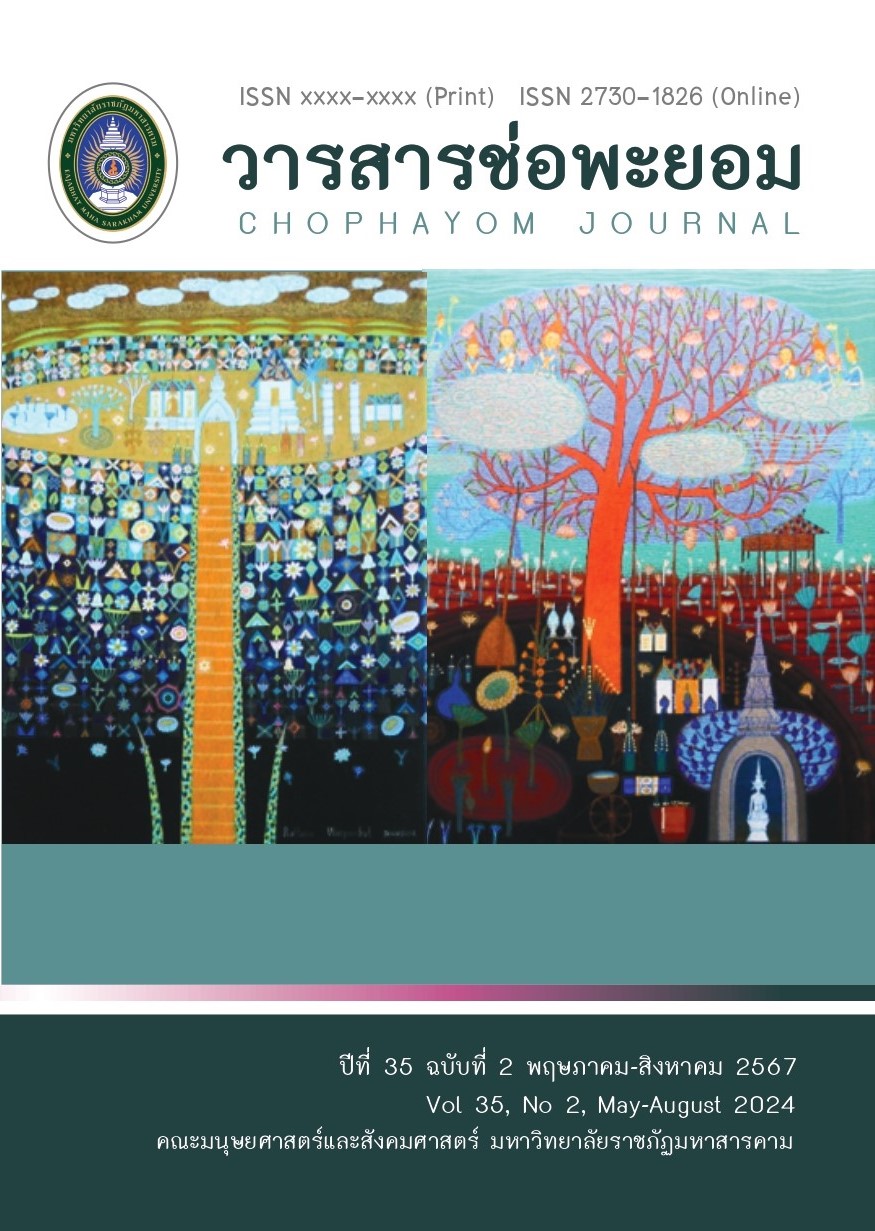The Love Patterns of Displaced Isan Characters in the Songs of Monkan Kankoon
Keywords:
Displaced Isan characters, Music, Monkan Kankoon, Love PathwaysAbstract
The research titled “The Love Pathways of Isan Diaspora Characters in the Songs of Monkan Kaenkoon” aims to study the love pathways of Isan diaspora characters as depicted in the songs of Monkan Kaenkoon during the period 2020-2024. This study analyzes a total of 16 songs available on www.youtube.com, utilizing the concepts of Diasporas by William Safran (1991) and Osten Wahlbeck (2002), as well as the concepts of Diasporic Identity by Stuart Hall (1994) and Paul Gilroy (1997). The result revealed that Monkan Kaenkoon’s songs present three distinct love pathways of Isan diaspora characters: 1) Nostalgia for past love, 2) Desire for love, and 3) Longing for love at home. These findings illustrate how themes of romantic relationships between young men and women are interwoven to create emotional bonds, fostering a sense of attachment to their homeland among the Isan diaspora characters.
Keywords: Displaced Isan characters, Music, Monkan Kankoon, Love Pathways
References
กิตติพงษ์ พลทิพย์. (2565). “จิตวิทยาความรักกับวรรณกรรมพื้นบ้านอีสาน”, วารสารวิชาการรัตนบุศย์, 4(2), 139-145.
ฐิรวุฒิ เสนาคำ และคณะ. (2546). คนพลัดถิ่น : เอกสารประกอบการประชุมประจำปีทางมานุษยวิทยา ครั้งที่ 2 เรื่องชาติและชาติพันธุ์. กรุงเทพฯ: สำนักงานกองทุนสนับสนุนการวิจัย (สกว.).
ฐิรวุฒิ เสนาคำ. (2559). “ไทยพลัดถิ่นในต่างแดน”, ใน พัทยา เรือนแก้ว, สุภางค์ จันทวานิช และฉันทนา บรรพศิริโชติ (บรรณาธิการ). ไทยต่างด้าวท้าวต่างแดน : สังคมวิทยาของชีวิตข้ามพรมแดน. หน้า 118. กรุงเทพฯ : สำนักพิมพ์แห่งจุฬาลงกรณ์มหาวิทยาลัย.
ปิ่นแก้ว เหลืองอร่ามศรี. (2545). “ข้ามพรมแดนกับคำถามเรื่องอัตลักษณ์วัฒนธรรม พื้นที่ และความเป็นชาติ”, วารสารสังคมศาสตร์มหาวิทยาลัยเชียงใหม่. 15(1), 1-14.
พีรพงษ์ เคนทรภักดิ์. (2564). วาทกรรมความรักในบทเพลงลูกทุ่งอีสานร่วมสมัย. (วิทยานิพนธ์ปริญญาศิลปศาสตรมหาบัณฑิต, มหาวิทยาลัยมหาสารคาม).
มนต์ชัย ผ่องศิริ และมณีมัย ทองอยู่. (2556). “คนเข้าเมืองทั่วไปหรือคนพลัดถิ่น? : การต่อรองนิยามตัวตนของไทยพลัดถิ่นในสังคมไทย”, วารสารสังคมลุ่มน้ำโขง, 9(2), 1-24.
แวง พลังวรรณ. (2545). อีสานคดีชุด ลูกทุ่งอีสาน. กรุงเทพฯ: เรือนปัญญา.
ศิราพร ฐิตะฐาน ณ ถลาง. (2558). คติชนในบริบทข้ามพรมแดน งานปอยไทใหญ่ในจังหวัดเชียงใหม่. กรุงเทพฯ: สำนักพิมพ์แห่งจุฬาลงกรณ์มหาวิทยาลัย.
สิริชญา คอนกรีต. (2556). เพลงลูกทุ่งอีสาน: อัตลักษณ์และการเมืองเชิงวัฒนธรรมของคนอีสานพลัดถิ่น. (วิทยานิพนธ์ปริญญาอักษรศาสตรดุษฎีบัณฑิต, มหาวิทยาลัยศิลปากร).
เหมือนฝัน คงสมแสวง, พันธกานต์ ทานนท์ และพรสุรีย์ วิภาศรีนิมิต. (2564). “กลยุทธ์การสื่อสารดิจิทัลอัลบั้มเพลงลูกทุ่งอีสาน: มนต์แคน แก่นคูน”, วารสารนิเทศศาสตร์ธรุกิจบัณฑิตย์, 15(2), 33-73.
ออมสิน บุญเลิศ. (2551). การต่อรองและปรับตัวของคนพลัดถิ่น : กรณีศึกษาชาวไทใหญ่พลัดถิ่นในเมืองเชียงใหม่. (วิทยานิพนธ์ศิลปศาสตรมหาบัณฑิต, มหาวิทยาลัยเชียงใหม่).
อัฐพล อินต๊ะเสนา. (2560). “เรื่องเล่ากับการสร้างพื้นที่ผ่านเครือข่ายทางสังคมของคนไทยอีสานพลัดถิ่น”, วารสารวิชาการและวิจัยสังคมศาสตร์, 12(34), 67-82.
Baumann, M. (2000). “Diaspora: Genealogies of Semantics and Transcultural Comparison”, Numen, 47(3), 313-337.
ChartMasters. (2021). YouTube’s Most Streamed Artists of 2020. สืบค้นเมื่อ 5 สิงหาคม 2567, จาก chartmasters.org/2021/01/youtubes-most-streamed-artists-of-2020.
Cohen, R. (1996). “Diasporas and the Nation-State: from Victims to Challengers”, International Affairs, 72(3), 507-520.
Safran, W. (1991). “Diaspora in Modern Societies: Myths of Homeland and Return”, Diaspora: A Journal of Transnational Studies, 1(1), 83-99.
Wahlbeck, O. (2002). “The Concept of Diaspora as an Analytical Tool in the Study of Refugee Communities”, Journal of Ethnic and Migration Studies, 28(2), 221-238.
Downloads
Published
How to Cite
Issue
Section
License
Copyright (c) 2024 Chophayom Journal

This work is licensed under a Creative Commons Attribution-NonCommercial-NoDerivatives 4.0 International License.




